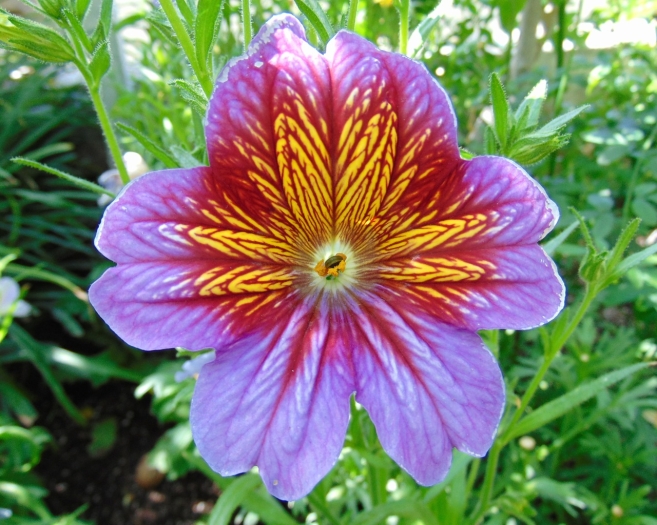Painted Tongue
(Salpiglossis sinuata)
Painted Tongue (Salpiglossis sinuata)
/
/

Nadiatalent
CC BY-SA 4.0
Image By:
Nadiatalent
Recorded By:
Copyright:
CC BY-SA 4.0
Copyright Notice:
Photo by: Nadiatalent | License Type: CC BY-SA 4.0 | License URL: https://creativecommons.org/licenses/by-sa/4.0 | Uploader: Nadiatalent | Publisher: Wikimedia Commons | Title: Salpiglossis_bloom_at_Allan_Gardens,_Toronto.jpg | Notes: {{Information |Description=''[[Salvia chamaedryoides]]'' [[Springs Preserve]] garden, [[Las Vegas, Nevada]] |Source=self-made |Date=15 April 2006 |Author= [[User:Stan Shebs|Stan Shebs]] |Permission=see below |other_versions= }} {{Stan Shebs























Estimated Native Range
Summary
Salpiglossis sinuata, commonly known as Painted Tongue, is an annual herb native to the temperate regions of Chile and Argentina in South America, where it thrives in open areas and disturbed sites. It typically grows to 60 cm (2.0 ft) tall, but can occasionally reach up to 1 m (3.3 ft) in height. Painted Tongue is characterized by its deeply veined, trumpet-shaped flowers that come in a variety of colors including blue, yellow, orange, pink, purple, and red, blooming profusely in the spring and summer months. The flowers are quite showy, making it a favorite for adding vibrant color to gardens.
In cultivation, Painted Tongue is valued for its ease of maintenance and the bright splash of color it brings to garden beds and borders. It is often used in annual displays, container plantings, and as an accent plant in mixed borders. This plant prefers full sun exposure and well-drained soil with moderate fertility. While it tolerates low water conditions, consistent moisture will promote better flowering. Deadheading spent flowers can encourage a longer blooming period. Although generally pest-free, it can be susceptible to fungal diseases in humid conditions.CC BY-SA 4.0
In cultivation, Painted Tongue is valued for its ease of maintenance and the bright splash of color it brings to garden beds and borders. It is often used in annual displays, container plantings, and as an accent plant in mixed borders. This plant prefers full sun exposure and well-drained soil with moderate fertility. While it tolerates low water conditions, consistent moisture will promote better flowering. Deadheading spent flowers can encourage a longer blooming period. Although generally pest-free, it can be susceptible to fungal diseases in humid conditions.CC BY-SA 4.0
Plant Description
- Plant Type: Herb
- Height: 2-3 feet
- Width: 0.667-1 feet
- Growth Rate: Moderate
- Flower Color: Blue, Orange, Purple, Red, Yellow
- Flowering Season: Spring, Summer
- Leaf Retention:
Growth Requirements
- Sun: Full Sun
- Water: Medium
- Drainage: Medium
Common Uses
Bee Garden, Butterfly Garden, Deer Resistant, Low Maintenance, Potted Plant, Showy Flowers
Natural Habitat
Temperate regions of Chile and Argentina, thriving in open areas and disturbed sites
Other Names
Common Names: Scalloped Tube Tongue, Velvet Trumpet Flower, Palito Amargo, Painted-Tongue, Trompetenzunge, Salpiglossis, Trumpetblomma
Scientific Names: , Salpiglossis sinuata, Salpiglossis atropurpurea, Salpiglossis picta, Salpiglossis straminea, Salpiglossis barcklayana, Salpiglossis intermedia, Salpiglossis variabilis, Salpiglossis hybrida, Phyteuma tricolor
GBIF Accepted Name: Salpiglossis sinuata Ruiz & Pav.